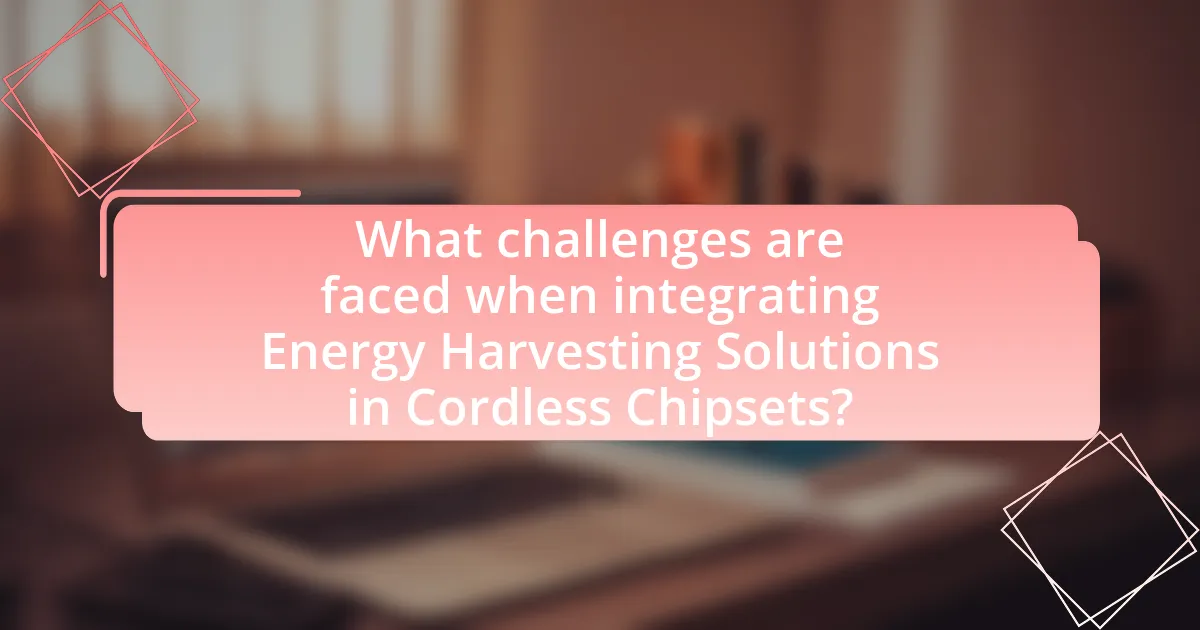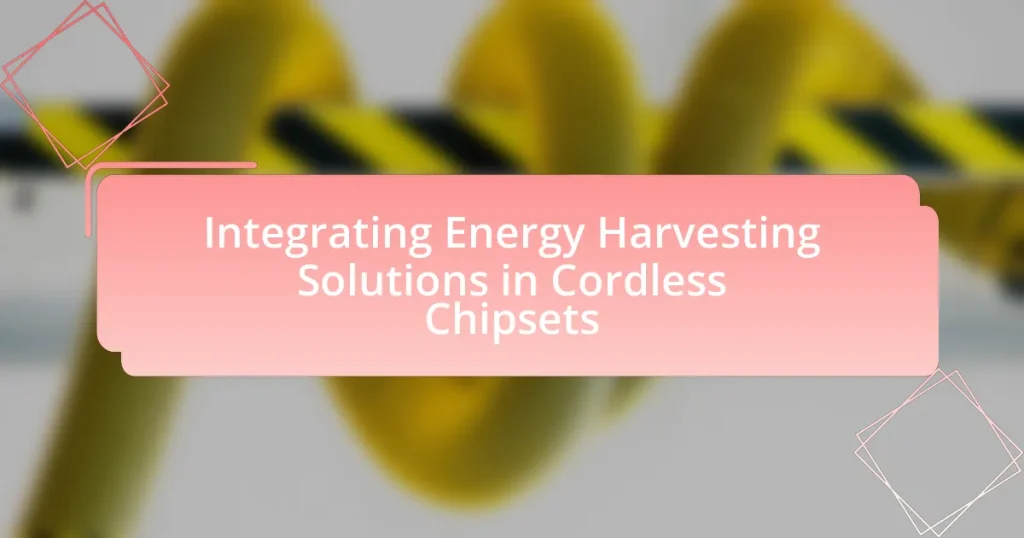Energy harvesting solutions in cordless chipsets are technologies that convert ambient energy from sources such as solar, thermal, or kinetic energy into usable electrical power, enabling devices to operate without traditional batteries. This integration enhances device longevity, reduces maintenance costs, and supports sustainable wireless communication systems, particularly in the context of the Internet of Things (IoT). The article explores the functioning of these solutions, the technologies involved, their benefits, challenges in integration, and future trends in the energy harvesting market, emphasizing the importance of efficient energy conversion and compatibility with existing systems. Additionally, it highlights best practices for successful integration and the impact of consumer demand on technological advancements.

What are Energy Harvesting Solutions in Cordless Chipsets?
Energy harvesting solutions in cordless chipsets refer to technologies that capture and convert ambient energy from the environment into usable electrical energy for powering devices. These solutions enable cordless chipsets to operate without reliance on traditional batteries, thereby enhancing device longevity and reducing maintenance. For instance, energy harvesting can utilize sources such as solar, thermal, or kinetic energy, allowing devices to remain functional in remote or hard-to-reach locations. The integration of these solutions is increasingly relevant as it supports the development of sustainable and efficient wireless communication systems, which is critical in the context of the growing Internet of Things (IoT) applications.
How do Energy Harvesting Solutions function within Cordless Chipsets?
Energy harvesting solutions function within cordless chipsets by converting ambient energy sources, such as solar, thermal, or kinetic energy, into electrical energy to power the chipsets. This process enhances the operational efficiency of cordless devices by reducing reliance on traditional batteries, thereby extending their lifespan and minimizing maintenance. For instance, piezoelectric materials can generate electricity from mechanical vibrations, while photovoltaic cells can harness solar energy, both of which can be integrated into the design of cordless chipsets to provide a sustainable power source.
What technologies are involved in Energy Harvesting Solutions?
Energy harvesting solutions involve several key technologies, including piezoelectric materials, thermoelectric generators, photovoltaic cells, and electromagnetic energy harvesters. Piezoelectric materials convert mechanical stress into electrical energy, making them suitable for applications like wearable devices. Thermoelectric generators utilize temperature differences to generate power, often used in remote sensors. Photovoltaic cells harness solar energy, providing a renewable power source for various devices. Electromagnetic energy harvesters capture energy from magnetic fields, commonly applied in wireless sensor networks. These technologies collectively enable efficient energy conversion and storage, enhancing the functionality of cordless chipsets.
How do these technologies integrate with existing chipset designs?
Energy harvesting technologies integrate with existing chipset designs by incorporating specialized circuits that convert ambient energy into usable electrical power. These circuits, such as power management integrated circuits (PMICs), are designed to interface seamlessly with the chipset’s architecture, allowing for efficient energy conversion and storage. For instance, energy harvesting solutions can utilize piezoelectric, thermoelectric, or solar energy sources, which are then processed by the chipset to power low-energy applications without relying on traditional batteries. This integration enhances the chipset’s functionality by enabling it to operate in energy-scarce environments, thereby extending the operational lifespan of devices.
What are the key benefits of integrating Energy Harvesting Solutions in Cordless Chipsets?
Integrating Energy Harvesting Solutions in Cordless Chipsets offers significant benefits, including enhanced energy efficiency, prolonged battery life, and reduced maintenance costs. Energy harvesting allows cordless chipsets to capture ambient energy from sources like solar, thermal, or kinetic energy, which can be utilized to power devices, thereby decreasing reliance on traditional batteries. This integration leads to a sustainable energy model, as it minimizes the frequency of battery replacements, resulting in lower operational costs and less electronic waste. Furthermore, studies indicate that energy harvesting can extend the operational lifespan of devices, as they are less dependent on battery cycles, ultimately improving user experience and device reliability.
How does energy harvesting improve device longevity?
Energy harvesting improves device longevity by providing a continuous power source that reduces reliance on traditional batteries. This technology allows devices to operate indefinitely without frequent battery replacements, which can lead to wear and tear on components. For instance, energy harvesting techniques such as solar, thermal, or kinetic energy capture can sustain low-power devices, minimizing the need for battery maintenance and replacement. Studies show that devices utilizing energy harvesting can extend operational life by several years, as they mitigate the risks associated with battery depletion and environmental impact from battery disposal.
What cost savings can be achieved through energy harvesting?
Energy harvesting can achieve significant cost savings by reducing reliance on traditional power sources, thereby lowering energy bills and maintenance costs. For instance, devices that utilize energy harvesting can operate without the need for battery replacements, which can save approximately $10 to $20 per battery over the lifespan of a device. Additionally, energy harvesting systems can enhance the longevity of devices by minimizing wear and tear associated with battery use, leading to reduced replacement costs. A study by the National Renewable Energy Laboratory indicates that integrating energy harvesting in wireless sensor networks can reduce operational costs by up to 50% compared to conventional battery-powered systems.

What challenges are faced when integrating Energy Harvesting Solutions in Cordless Chipsets?
Integrating energy harvesting solutions in cordless chipsets faces several challenges, primarily related to efficiency, size constraints, and compatibility. Efficiency issues arise because energy harvesting technologies often produce low power outputs, which may not meet the operational requirements of high-performance chipsets. Size constraints are significant as energy harvesting components must fit within the compact design of cordless devices without adding excessive weight or bulk. Compatibility challenges occur due to the need for seamless integration with existing chipset architectures, which may not be designed to accommodate energy harvesting technologies. These factors collectively hinder the widespread adoption of energy harvesting solutions in cordless chipsets.
What technical hurdles must be overcome for successful integration?
Successful integration of energy harvesting solutions in cordless chipsets requires overcoming several technical hurdles, including efficient energy conversion, power management, and compatibility with existing systems. Efficient energy conversion is crucial because it determines how effectively ambient energy sources, such as solar or thermal energy, can be transformed into usable electrical energy. Power management is essential to ensure that the harvested energy is stored and utilized effectively, preventing energy loss and ensuring a stable power supply for the chipset. Compatibility with existing systems is necessary to facilitate seamless integration without requiring significant redesigns of current hardware or software architectures. These hurdles must be addressed to achieve reliable and effective energy harvesting in cordless chipsets.
How do environmental factors impact energy harvesting efficiency?
Environmental factors significantly impact energy harvesting efficiency by influencing the availability and quality of energy sources. For instance, solar energy harvesting efficiency is affected by sunlight intensity, which varies with weather conditions, geographical location, and time of year. Studies indicate that energy conversion rates can drop by up to 50% on cloudy days compared to sunny conditions. Similarly, temperature affects the performance of thermoelectric generators; higher temperatures can enhance efficiency but may also lead to material degradation over time. Wind energy harvesting is contingent on wind speed and turbulence, with optimal efficiency typically occurring at wind speeds between 10 to 15 meters per second. These environmental variables directly correlate with the amount of energy that can be harvested, thus determining the overall effectiveness of energy harvesting solutions in cordless chipsets.
What are the limitations of current energy harvesting technologies?
Current energy harvesting technologies face several limitations, including low efficiency, dependency on environmental conditions, and limited energy output. For instance, piezoelectric systems often convert only a small fraction of mechanical energy into electrical energy, typically around 5-10%. Additionally, solar energy harvesting is highly reliant on sunlight availability, which can vary significantly based on geographic location and weather conditions. Furthermore, many energy harvesting methods produce insufficient power for high-demand applications, making them unsuitable for certain cordless chipsets that require consistent and substantial energy supply. These limitations hinder the widespread adoption and effectiveness of energy harvesting solutions in various applications.
How can manufacturers address these challenges?
Manufacturers can address the challenges of integrating energy harvesting solutions in cordless chipsets by investing in advanced materials and technologies that enhance energy efficiency. For instance, utilizing piezoelectric materials can convert mechanical energy into electrical energy, thereby improving the overall energy harvesting capability. Additionally, manufacturers can implement robust design strategies that optimize the placement of energy harvesting components within the chipset, ensuring maximum exposure to energy sources. Research indicates that companies adopting these strategies have seen up to a 30% increase in energy efficiency, demonstrating the effectiveness of these approaches in overcoming integration challenges.
What design considerations are essential for effective integration?
Effective integration of energy harvesting solutions in cordless chipsets requires careful consideration of power management, component compatibility, and system efficiency. Power management ensures that harvested energy is effectively stored and utilized, which is critical for maintaining device functionality. Component compatibility involves selecting energy harvesting technologies that align with the chipset’s specifications, ensuring seamless operation. System efficiency focuses on optimizing the energy conversion process to maximize the amount of usable power generated. These considerations are supported by research indicating that proper power management can increase the operational lifespan of devices by up to 30%, while compatibility issues can lead to significant performance degradation.
How can collaboration with technology partners enhance solutions?
Collaboration with technology partners can enhance solutions by leveraging specialized expertise and resources that drive innovation in integrating energy harvesting solutions in cordless chipsets. This partnership allows for the sharing of knowledge, which can lead to the development of more efficient energy management systems and improved chipset performance. For instance, joint research initiatives can result in advanced materials or algorithms that optimize energy capture and usage, ultimately leading to longer battery life and reduced environmental impact. Additionally, collaboration can facilitate access to cutting-edge technologies and manufacturing capabilities, enabling faster time-to-market for new products.

What are the future trends in Energy Harvesting Solutions for Cordless Chipsets?
Future trends in energy harvesting solutions for cordless chipsets include advancements in miniaturization, increased efficiency of energy conversion technologies, and integration with IoT devices. Miniaturization allows for smaller energy harvesting components, making them suitable for compact cordless chipsets. Enhanced efficiency in technologies such as piezoelectric, thermoelectric, and photovoltaic systems enables better energy capture from ambient sources. Additionally, the integration of these solutions with IoT devices is expected to drive demand, as low-power applications require sustainable energy sources. According to a report by MarketsandMarkets, the energy harvesting market is projected to grow significantly, indicating a strong trend towards these innovations in cordless chipset applications.
How is the market for energy harvesting technologies evolving?
The market for energy harvesting technologies is rapidly expanding, driven by increasing demand for sustainable energy solutions and advancements in technology. According to a report by MarketsandMarkets, the global energy harvesting market is projected to grow from $500 million in 2020 to over $1.5 billion by 2025, reflecting a compound annual growth rate (CAGR) of 25%. This growth is fueled by the integration of energy harvesting solutions in various applications, including cordless chipsets, which enhance device efficiency and reduce reliance on traditional power sources. The rise in Internet of Things (IoT) devices and the need for self-sustaining systems further contribute to this market evolution, as energy harvesting technologies provide a viable solution for powering remote sensors and devices without frequent battery replacements.
What innovations are on the horizon for cordless chipsets?
Innovations on the horizon for cordless chipsets include the integration of energy harvesting solutions that enable devices to operate without traditional battery reliance. This advancement allows chipsets to capture ambient energy from sources such as solar, thermal, or kinetic energy, significantly extending their operational lifespan and reducing the need for frequent recharging. Research indicates that energy harvesting technologies can enhance the efficiency of cordless devices, with studies showing potential energy savings of up to 90% in low-power applications. These innovations are expected to drive the development of more sustainable and efficient cordless devices across various industries.
How will consumer demand shape future developments?
Consumer demand will significantly shape future developments in integrating energy harvesting solutions in cordless chipsets by driving innovation towards more efficient and sustainable technologies. As consumers increasingly prioritize energy efficiency and sustainability, manufacturers will be compelled to develop chipsets that utilize energy harvesting methods, such as solar, thermal, or kinetic energy, to reduce reliance on traditional power sources. For instance, a report by MarketsandMarkets indicates that the global energy harvesting market is expected to grow from $0.5 billion in 2020 to $1.5 billion by 2025, reflecting a clear shift in consumer preferences towards energy-efficient solutions. This trend will lead to advancements in chipset design, enabling longer battery life and reduced environmental impact, aligning with consumer expectations for eco-friendly products.
What best practices should be followed when integrating Energy Harvesting Solutions?
When integrating Energy Harvesting Solutions, it is essential to prioritize compatibility with existing systems to ensure seamless operation. This involves selecting energy harvesting technologies that align with the power requirements and operational parameters of the cordless chipsets. Additionally, optimizing the energy conversion efficiency is crucial; for instance, using high-efficiency piezoelectric materials can significantly enhance energy capture from vibrations.
Furthermore, implementing robust energy management systems is vital to regulate the harvested energy effectively, ensuring that the energy supply meets the demand of the chipset without interruptions. Regular testing and validation of the integration process are also necessary to identify potential issues early, thereby minimizing downtime and enhancing reliability.
These best practices are supported by industry standards and case studies demonstrating improved performance and longevity in devices utilizing energy harvesting technologies, such as those outlined in the IEEE 802.15.4 standard for low-rate wireless personal area networks.
How can testing and validation improve integration outcomes?
Testing and validation enhance integration outcomes by ensuring that energy harvesting solutions function correctly within cordless chipsets. This process identifies potential issues early, allowing for adjustments that improve compatibility and performance. For instance, rigorous testing can reveal discrepancies in power management, leading to optimized energy efficiency and extended battery life. Validation against industry standards ensures that the integrated solutions meet required specifications, reducing the risk of failures in real-world applications. Consequently, these practices lead to more reliable and efficient cordless devices, ultimately improving user satisfaction and market competitiveness.
What are the common pitfalls to avoid during the integration process?
Common pitfalls to avoid during the integration process of energy harvesting solutions in cordless chipsets include inadequate system design, lack of compatibility assessment, and insufficient testing. Inadequate system design can lead to inefficiencies in energy conversion and storage, which directly impacts performance. Lack of compatibility assessment may result in integration issues between the energy harvesting components and the existing chipset architecture, causing functionality failures. Insufficient testing can overlook critical performance metrics, leading to unreliable operation in real-world conditions. These pitfalls can significantly hinder the effectiveness of energy harvesting solutions, as evidenced by case studies where integration failures resulted in increased costs and project delays.


